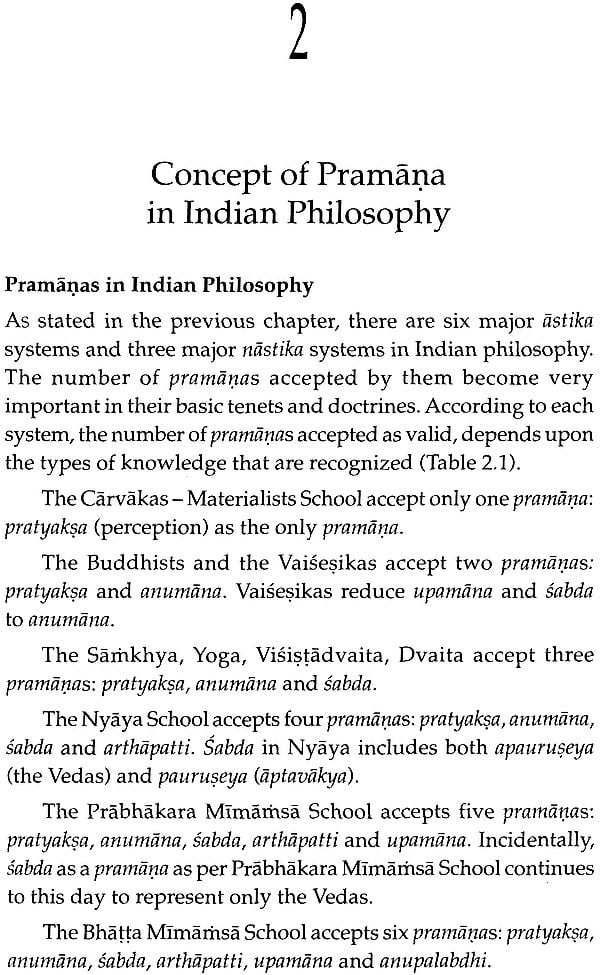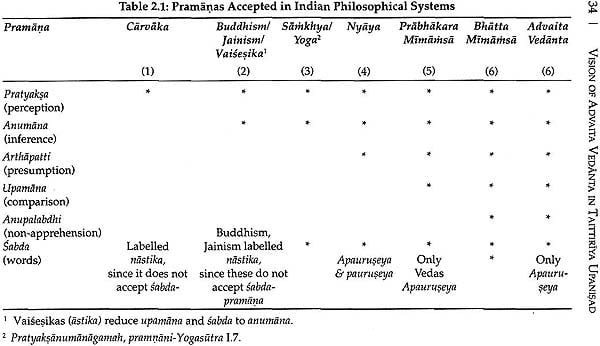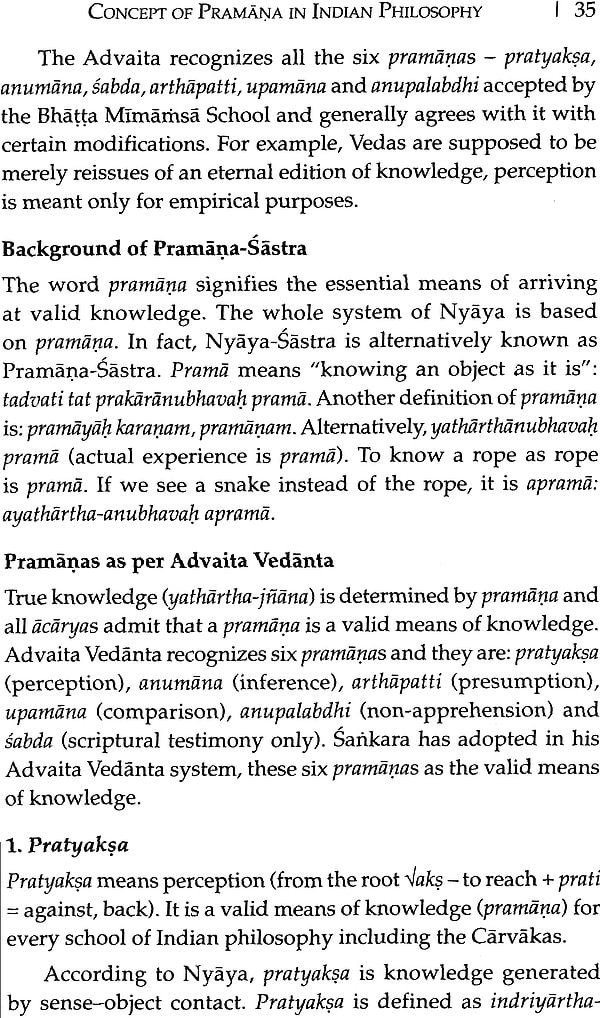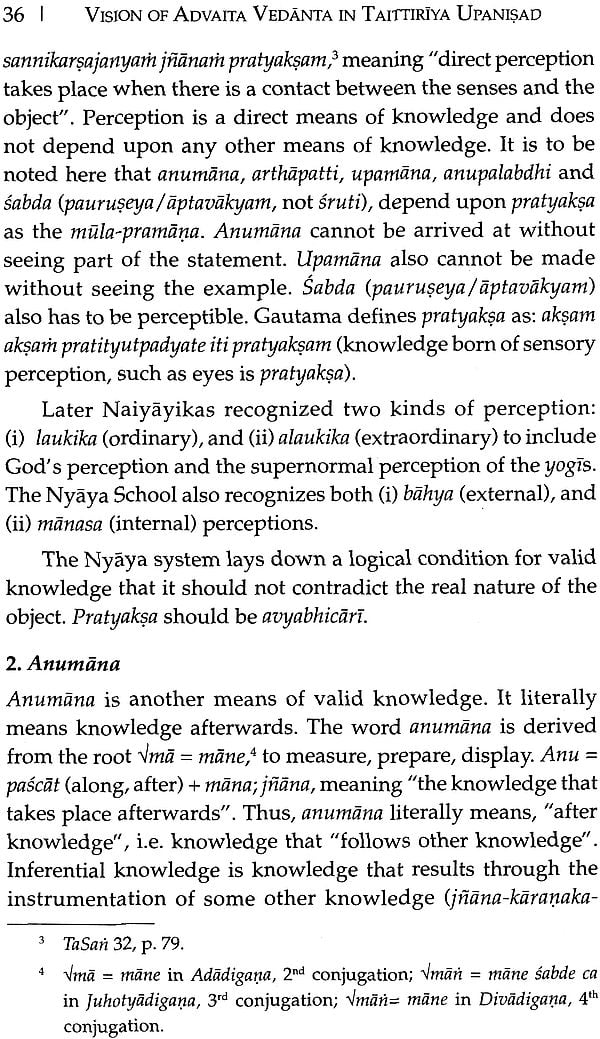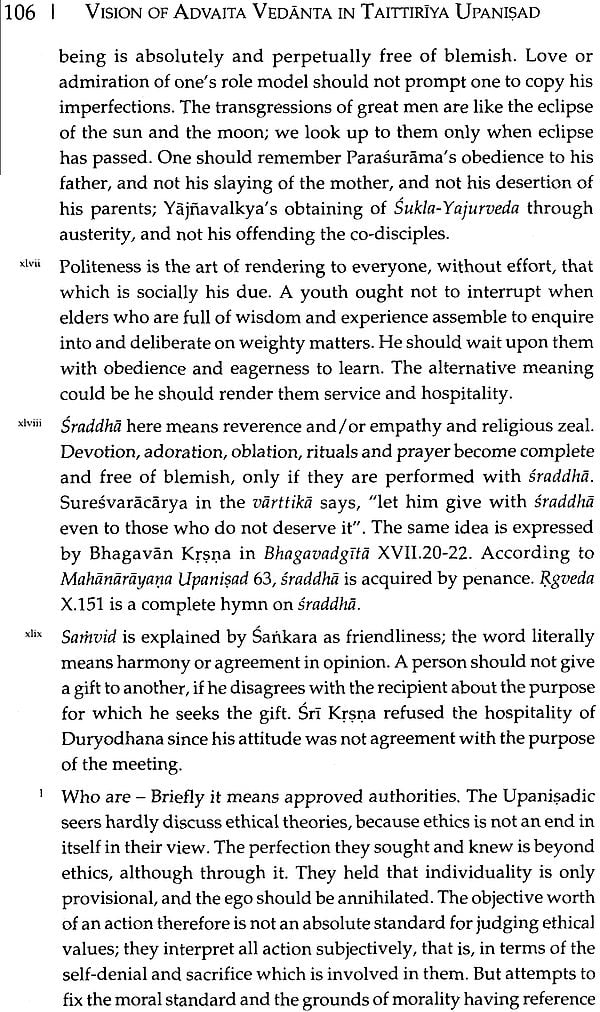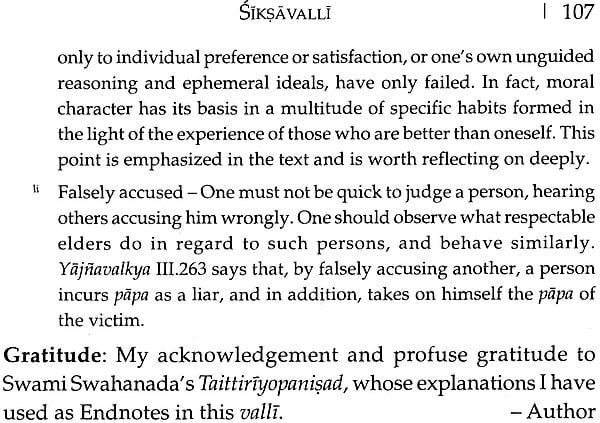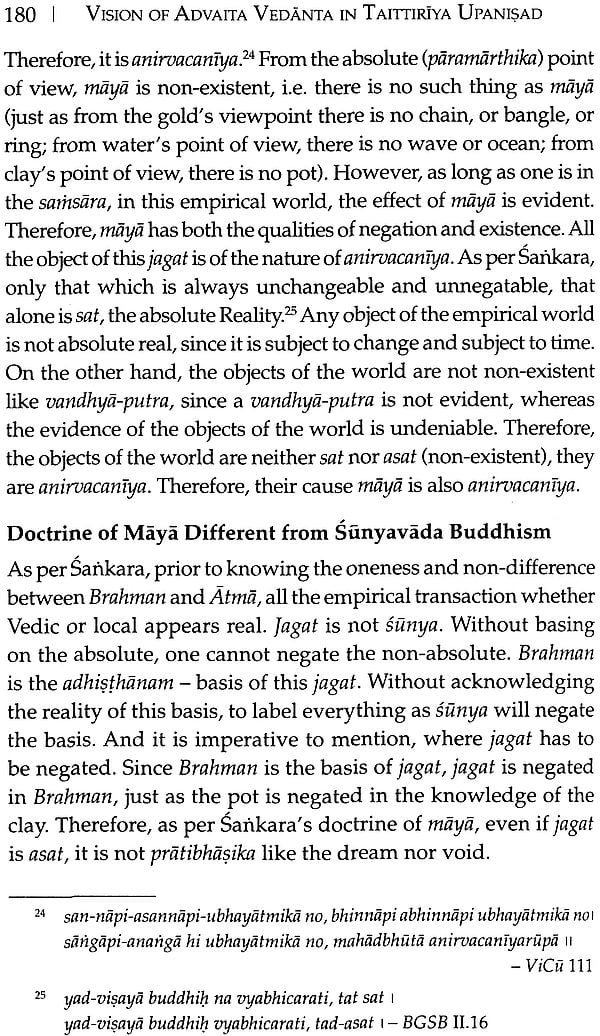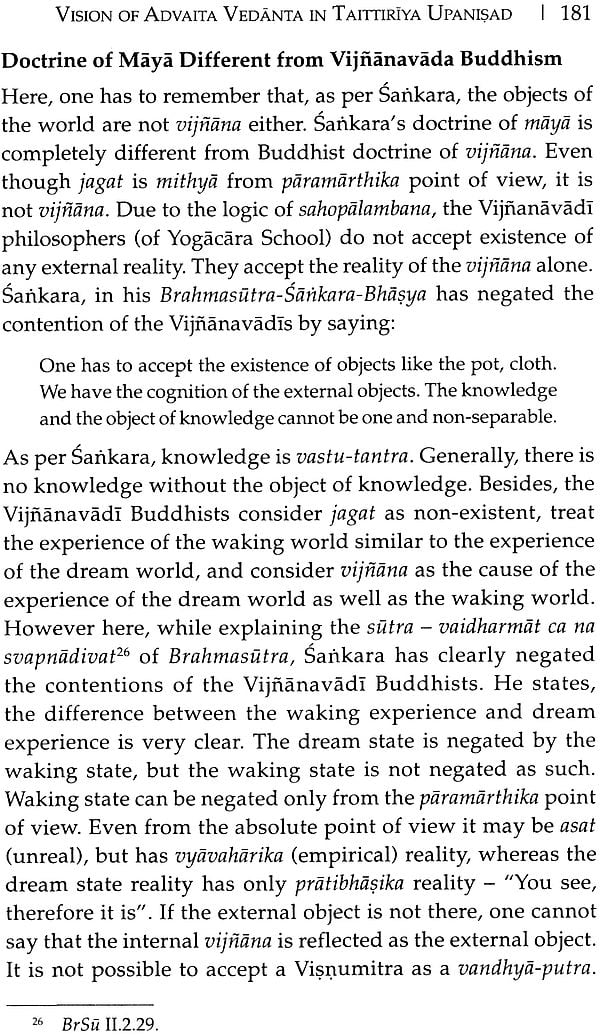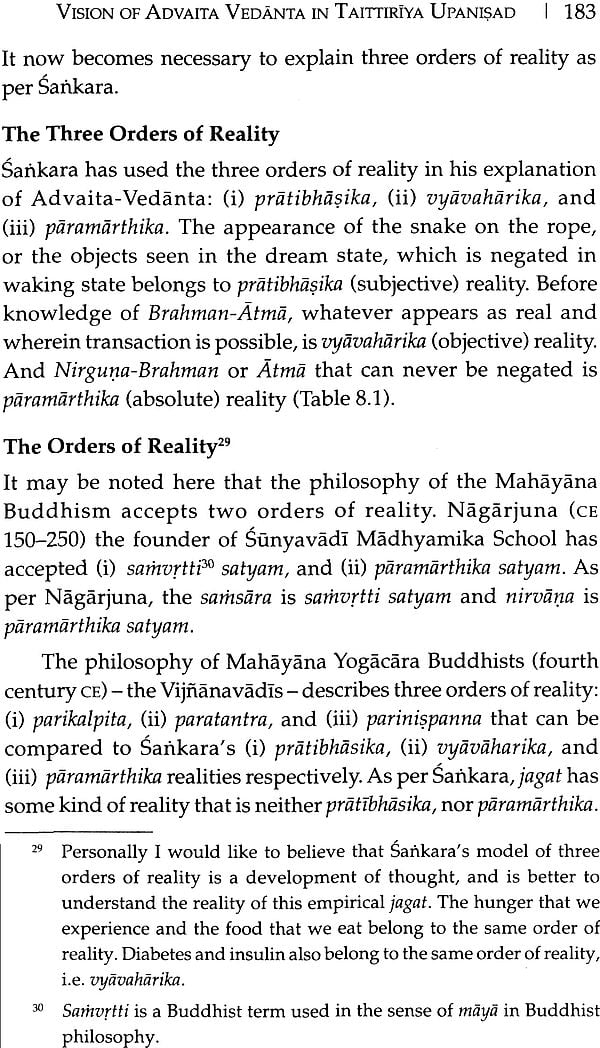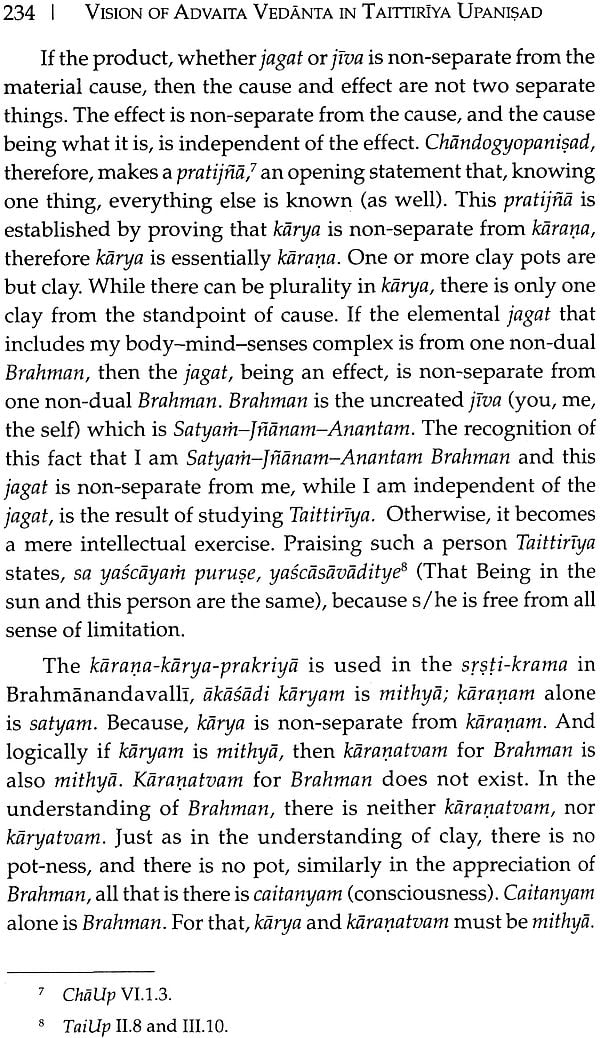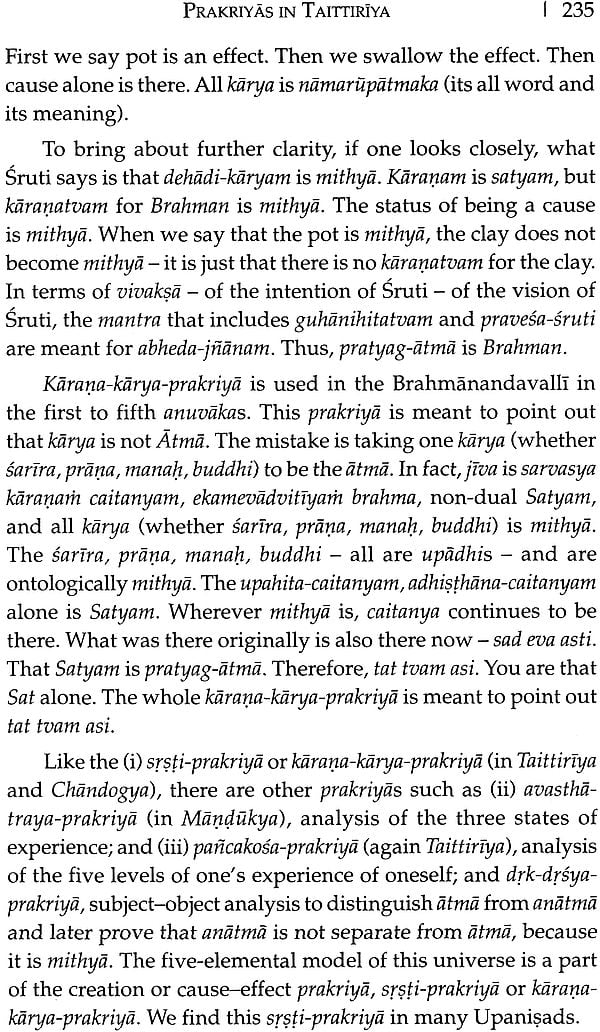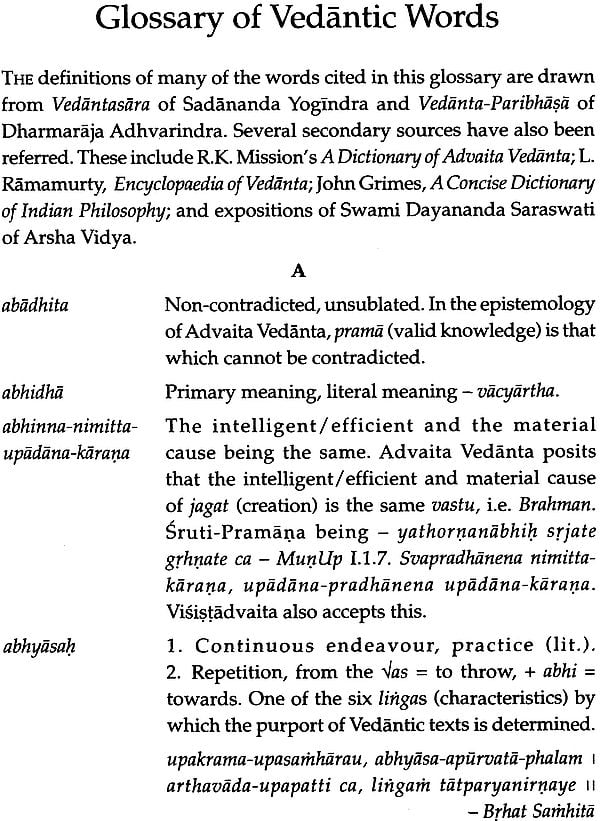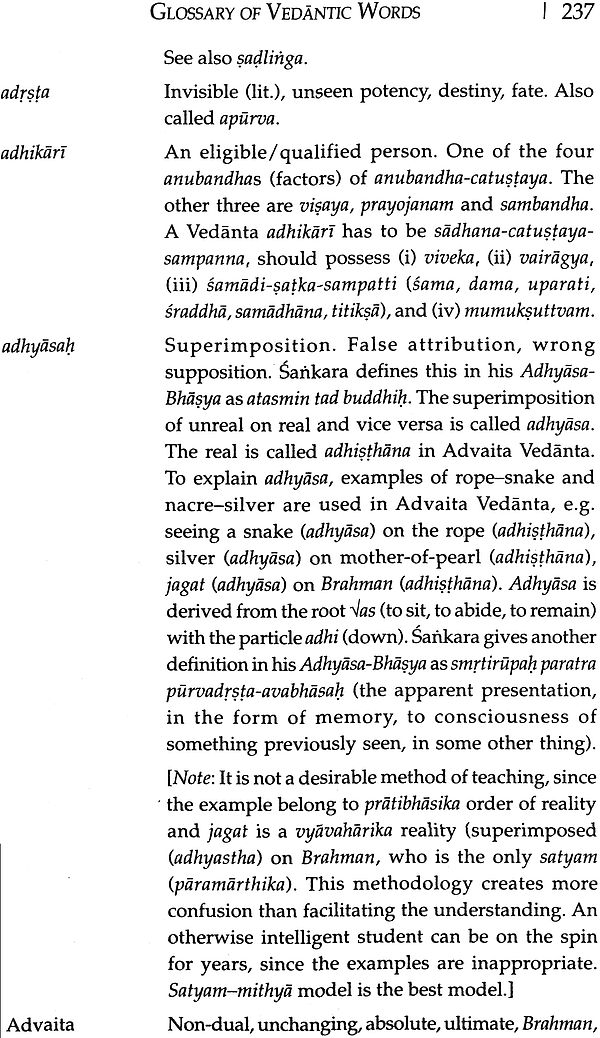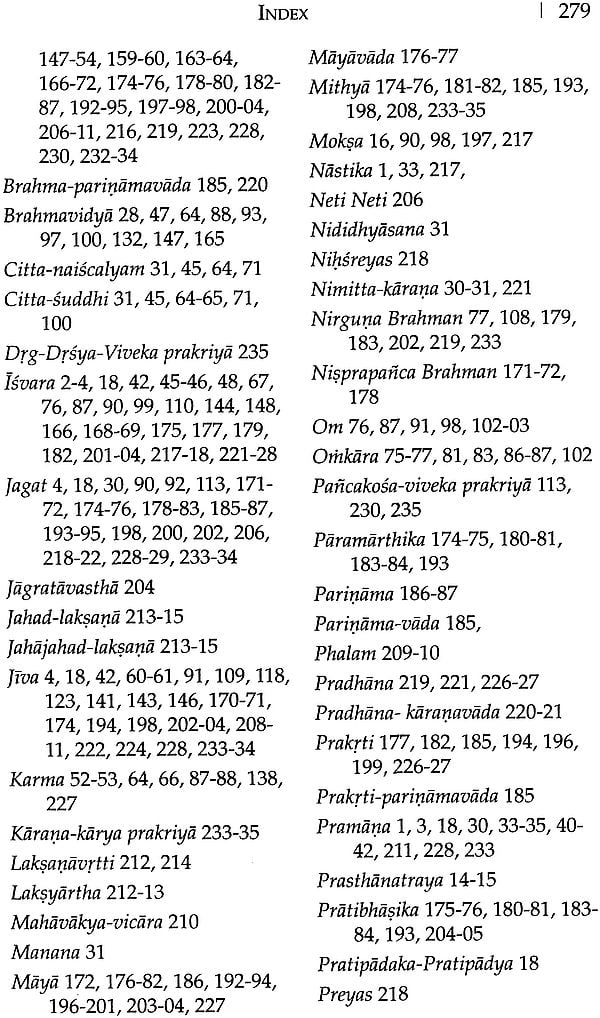
Vision of Advaita Vedanta in Taittiriya Upanisad (With Special Reference to Sankarabhasya)
Book Specification
| Item Code: | NAN424 |
| Author: | Swamini Atmaprajnananda Saraswati |
| Publisher: | D. K. Printworld Pvt. Ltd. |
| Language: | Sanskrit Text With Transliteration and English Translation |
| Edition: | 2016 |
| ISBN: | 9788124608531 |
| Pages: | 300 |
| Cover: | Hardcover |
| Other Details | 8.5 inch x 5.5 inch |
| Weight | 560 gm |
Book Description
This book unveils the vision of Advaita Vedanta in Taittiriya Upanisad with special reference to Sankarabhasya in a unique style. Upanisads are sabda-pramana, and this work adequately details the six pramanas, which hold the key to understand the significance of sabda-pramana, along with the five santi-mantras in Taittiriya Upanisad. As the crux, it analyses Sankara’s commentary-Taittiriya-Bhasyam-on Taittiriya Upanisad, enabling one to understand the deep layers of Advaita Vedanta in detail.
The core theme "Vision of Advaita in Taittiriya Upanisad" discusses the oneness of the triangular phenomenon called jiva, jagat and Isvara. It delves deep into the method of deciphering the mahavakyas as well. While following closely the source literature, this volume attempts to detail the nuances of Taittiriya-Bhasyam. The approach of navigating the reader to the principal theme of Advaita Vedanta is expected to give him/her a good background. In ensuring this the volume provides relevant citations and informative explanatory notes. More importantly, it across three vallis Siksavalli, Brahmanandavalli and Bhrguvalli-provides free translations of Taittiritya Upanisad.
This elaborate and scholarly book is expected to add great value to students who wish to have a better understanding of the great Indian tradition called Advaita Vedanta.
Swamini Atmaprajnananda Saraswati is a student-disciple of Sri Swami Dayananda Saraswati (1930-2015), founder of "Arsha Vidya" tradition.
She is an Advaita Vedantin, a Vedic and Sanskrit Scholar, holding a Ph. D. in Sanskrit. Swamini is a Master in the Speaking Tree, and writes regularly on Advaita Vedanta.
Her published books are Dasasanti (2008), Rupasiddhi (2008), Nomenclature of the Vedas (2012), Rsikas of the Rgveda (2013), and Om: The Sound Symbol (2014).
Swamini teaches Vedanta and Sanskrit in Bhubaneswar and Rishikesh. In addition to her teaching and research activities, she has convened six National Conferences on Indology until now.
My interest Advaita Vedanta is a personal one, and this book is the outcome of my study over a number of years in traditional gurukulam. I began studying Advaita Vedanta twenty years ago in 1996, when I had the good fortune to sit at the feet of my Spiritual Guru His Holiness Swami Dayananda Saraswati.
Since Upanisads are sabda-pramana, I have retained certain words without translating such as ananda and mithya. I have also refrained from using the popular translations, i.e. illusion, realization, bliss and supreme, since they do not convey the same meaning to everyone.
In the translation and commentary, the words/ sentences in Sanskrit are given in italics in the main body or in the footnotes. These are followed by English equivalents. Citations are given in the footnotes, and informative explanatory notes have been added as endnotes especially for the Chapters 5. Siksavalli, 6. Brahmanandavalli, and 7. Bhrguvalli, These three chapters (5-7) are the bulk of the book where free translations of the Upanisad are given. My acknowledgement and profuse gratitude to Swami Swahanada's Taittiriyopanisad, whose explanations I have used as endnotes in these three vallis.
I consider Chapters 2, 4, 8 and 9 as the significant chapters of this book. Chapter 2 gives adequate details of the six pramanas, which are very important to understand the significance of sabda-pramana. Chapter 4 is the crux of the whole book, where I have analysed Sankara's commentary on Taittirfya. The Bhasyam I feel requires more than one time studying, since there are layers of understanding. A cursory study of this Upanisad may skip the depth of the commentary. Chapter 8, Vision of Advaita Vedanta, is the most important chapter where I have given my understanding of the triangle of the jiva, jagat and Isvara. Chapter 9 explains the method of deciphering the mahavakyas.
One may go through the thesis in the order of the chapters. Alternatively, one may go through Chapter 8 ''Vision of Advaita Vedanta", Chapter 4 on Taittiriua-Bhiisuam, which will be beneficial in understanding the deep layers of Advaita Vedanta in detail. These chapters should prove sufficient, and I look upon these as forming the principal chapters of the book. This approach will give the reader a good background on Advaita Vedanta.
I have closely used the source literature to the maximum. I do not pretend to have addressed and clarified all the terminological and other difficulties that stand in the way of a student in clearly comprehending their meanings. I however believe that I have been able to surface the nuances of Taittiriya-Bhasyam. I hope this work will be of great value to students of Advaita Vedanta who wish to have a better understanding of the great tradition that is Advaita Vedanta.
I bow down with reverential gratitude to all the great masters of Advaita Vedanta of the past, from whom I have learnt indirectly through their texts, and of present being my Spiritual Guru, His Holiness Swami Dayananda Saraswati (1930-2015) from whom I have directly learnt. In this context, I am reminded of the following couplet:
It is difficult to put in words what I owe to my Spiritual Guru Pujya Swami Dayananda Saraswati, under whose feet I studied the Upanisads, Bhagavadgita, Catussutri of Brahmasutra and many Prakarana Granthas. My eternal gratitude to Pujya Swami Dayananda Saraswatiji who so kindly wrote the Foreword to this book.
My gratitude to Swami Swahananda's Taittiriyopanisad, whose explanations I have used as endnotes in three chapters of this text.
My deep appreciation for Dr Satish and Shri Sugavanam Krishnan for having gone through the manuscript minutely and suggesting changes, and Medha Michika who so kindly worked out the rupasiddhi of "Upanisad".
My grateful thanks to Shri Akshay Kumar, for nursing me back to health through Jindal Naturecure Institute, and Smt. Payal Parija, for her consistent support during my years of studies and research.
I put forward my special gratitude to Shri Susheel Kumar Mittal, Director, D.K. Printworld, for his continuing support in I put forward my special gratitude to Shri Susheel Kumar Mittal, Director, D.K. Printworld for his continuing support in publishing my work. But for his support and encouragement this work would not have reached the readers so soon.
Indian Philosophical Systems
Indian philosophy is generally discussed in terms of six major orthodox (astika) schools, and three major heterodox (nastiku) schools. These words normally convey a division into theists and atheists. However, this is not the meaning implied when these terms are used to denote the schools of Indian philosophy. Astika systems are those that accept the authority (pramanattvam of the Vedas as a valid means of knowledge) of the Vedas, whereas nastika systems are those who reject it. The astika systems are the sad-darsanas, the six systems of Indian philosophy-Nyaya, Vaisesika, Samkhya, Yoga, Mimamsa and Vedanta. The nastika systems are Carvaka, Jainism and Buddhism.
The Vedas
The Vedic corpus that is accepted as pramana by the astika philosophies has four sections-Samhita, Brahmana, Aranyaka, and Upanisad. Samhita has Suktas or hymns. Brahmana contains the technical know-how of the fire ritual. Aranyaka has mantra and upasanas that are practised in the forests (i.e. not for grhasthas). Upanisads normally appear in the last part of Aranyaka and deal with spiritual philosophy. Some Upanisads are exceptions and appear in Samhita and Brahmana too. Thus Upanisads, as they appear in the last part of the Vedas, are called Vedanta. There are 108 Upanisads, out of which ten are famous. Since Upanisads are mostly philosophical, they are found in prose. However, there are Upanisads like Taittiriyopanisad, Ganapaiyatharvasirsopanisad and Isavasyopanisad that have svaras.
These four sections are mapped to the four asramas. A brahmacari is supposed to study the Samhita. A grhastha is supposed to follow the Brahmana. A vanaprasthi is supposed to follow the Aranyaka. A sannyasi is supposed to study the Upanisads.
Apauruseyatvam of the Vedas
Orthodox Indian thoughts maintain that the Vedas are revealed literature, i.e. they are not authored by any human being. Thus, the Vedas are said to be impersonal (apauruseya), and hence unquestionable. They are referred to as Sruti (that which is heard), and is accepted to be what was envisioned by the Vedic seers (rsis).
It is the Mimamsa that rejects the view that the Veda was ever composed by anybody. Nyaya-Vaisesika ascribes its authorship to Isvars. The position of Acarya Sankara about this view is midway between the two. Like the Mimamsa, but unlike the Nyaya-Vaisesika, he admits that the Veda is apauruseya. However, he redefines that word to make it signify not that the Veda has no author and is timeless, but that it is produced or, more properly, resuscitated at the beginning of each kalpa, by one that cannot interfere either with its content, or with the order of its words. In the case of works like Raghuvamsa, the author composes it as he likes. On the other hand, in case of the Vedas, the first creator of the Veda in every cycle who is Isvara, repeats it anew, but precisely as it was in the other cycles (pravaha-nityam). That is, the Veda is self-existent in this view also; only it is not the self-same Veda that always is, but a series of what may be described as re-issues of a timeless (pravaha-nityam) edition, which goes back to the beginningless time. This view is not different in substance from the Mimamsa view, excepting that it finds a place for lsvara in the doctrine. (Mimamsa does not accept lsvara).
As per Swami Dayananda Saraswati:
i Agnihotra and other ritual karmas are not matters of inference. There is no other way of knowing these karmas than Veda.
ii. There is no other pramana for knowing Atma to be Brahman, which is jagatkaranam and Paramesvara. Veda is pramana for atmajnanam.
iii. It is not pauruseya, because it is not born out of one's thinking box, not born of one's inference, or insight. If it occurs in somebody's head (a rsi), he calls himself "I am a drasta". These statements are revelation, hence they are called seers. Veda has to come from lsvara, because nobody else knows what Isvara is.
iv. This knowledge is apauruseyam, because the jivesvara aikyam equation is not a matter of inference. It is not a matter of inference. It is not pratyaksa, much less inference. lsvara Himself has to reveal the knowledge.
v Apauruseyatvam is an attitude, aauruseyatvam is no authorship. For any knowledge, any way there is no authorship. One discovers.
vi. If you have to learn Vedanta, you have to treat Vedas as pramana. There is no other way. It is not a system of philosophy. Vedanto nama upanisat pramanam (Ve Sa-3) "what is Vedanta is Upanisad as pramana".
vii. Veda/Vedanta is pramana because it is-anadhigata,
viii. Aithough most philosophical systems are discussed in the Brahmasutra, Vedanta is not a philosophical system.
Unlike in the Western philosophical systems, who wanted to keep religion and God out of their search for their basic question about the human being, this world and the creator; in India, religion and philosophy are together. Scholars have created a system out of the Vedas/Vedanta, nevertheless Isvara and devatas are an integral part of the whole philosophy.
Introduction to Vedanta
Vedanta (Upanisads) is the last word in search of the truth about the individual jiva, this jagat and the creator. Vedanta represents the doctrine of the total identity of the subject and object, beyond which human reason, thought and experience cannot go. This vision is held even by a farmer in a village (that all that is here is Bhagavan or Bhagavan is everywhere).
Contents
| Foreword | v | |
| Preface | vii | |
| Acknowledgement | xix | |
| Notes on Transliteration | xxi | |
| Abbreviations | xxiii | |
| 1 | Introduction to Vedanta | 1 |
| Indian Philosophical Syatems | 1 | |
| The Vedas | 1 | |
| Apauruseyatvam of the Vedas | 2 | |
| Introduction to Vedanta | 4 | |
| Knowledge of Upanisads Goes Outside India | 4 | |
| Meaning of the Word Vedanta | 6 | |
| Prasthanatraya of Vedanta | 14 | |
| Difference between Veda and Vedanta | 16 | |
| Subject Matter of Vedanta | 17 | |
| Anubandha-Catustaya | 17 | |
| Visaya (Subject Matter) | 17 | |
| Prayojanam (Purpose) | 17 | |
| Adhikari (Eligible Person) | 18 | |
| Sambandha (Relationship) | 18 | |
| The Philosophy of Vedanta | 18 | |
| Meaning of the Word Upa-in-sad | 20 | |
| Number of Upanisads | 23 | |
| Taittiriya Upanisad | 27 | |
| Significance of Taittiriya Upanisad in the Study of Vedanta | 29 | |
| Brahman as the abhinna-nimitta-upadana-karana of the Jagat | 30 | |
| Taittiriya Upanisad Quoted in the Brahmasutra | 32 | |
| 2 | Concept of Pramana in Indian Philosophy | 33 |
| Pramanas in Indian Philosophy | 33 | |
| Background of Pramana-Sastra | 35 | |
| Pramanas as per Advaita Vedanta | 35 | |
| Pratyaksa | 35 | |
| Anumana | 36 | |
| Arthapatti | 38 | |
| Upamana | 39 | |
| Anupalabdhi or Abhava | 40 | |
| Sabda | 41 | |
| Requisite Factors of Sabda-pramana | 43 | |
| 3 | The Five Santi-mantras in Taittiriya | 45 |
| Importance of Vedic Prayer | 45 | |
| Vedanta and Worship | 45 | |
| Difference between Upasana and Self-Knowledge | 45 | |
| First Santimantrah | 46 | |
| Second Santimantrah | 47 | |
| Third Santimantrah | 48 | |
| Fourth Santimantrah | 48 | |
| Fifth Santimantrah | 49 | |
| 4 | Taittiriya-Upanisad-Bhasyam | 50 |
| Definition of Bhasyam | 50 | |
| Siksavalli: First Anuvaka Futility of Karma) | 51 | |
| Siksavalli: Eleventh Anuvaka (Futility of Karma) | 52 | |
| Brahmanandavalli: 1st Anuvaka (Srstikrama) | 53 | |
| Brahmanandavalli: 3rd, 4th and 5th Anuvakas | 55 | |
| Brahmanandavalli: 5th Anuvaka and Bhrguvalli: 6th Anuvaka-Parity (Anandamaya same as Brahman? | 56 | |
| Brahmanandavalli: 6th Anuvaka (Anuprasnah) The Three Questions | 57 | |
| Brahmanandavalli: 6th Anuvaka (Pravesa-sruti) | ||
| Brahmanandavalli: 6th Anuvaka (Pravesa-sruti) | 59 | |
| Brahmanadavalli: 8th Anuvaka | 60 | |
| Brahmanandavalli: 4th and 9th Anuvakas (yato vaco nivartante) | 61 | |
| Bhrguvalli:10Th Anuvaka | 61 | |
| 5 | Siksavalli | 64 |
| Introduction to Siksavalli | 64 | |
| Summary of the Twelve Anuvakas | 65 | |
| First Anuvaka: Santimantrah | 67 | |
| Second Anuvaka: Siksa-sastrartha-sangrahah | 69 | |
| Various Upasanas in Taittiriya | 71 | |
| Third Anuvaka: Samhita-Upasana | 71 | |
| Fourth Anuvaka: Medhadi-siddhyartha Avahanti-homa-mantra | 75 | |
| Fifth Anuvaka: Vyahrti Upasana | 80 | |
| Sixth Anuvaka: Hiranyagarbha-Upasana | 83 | |
| Seventh Anuvaka: Panktabrahma-Upasana | 85 | |
| Eighth Anuvaka: Omkara-Upasana | 86 | |
| Personal Human Values (Antaranga-Sadhana) in Taittiriya | 87 | |
| Ninth Anuvaka: Svadhyaya-Prasamsa (Antaranga-Sadhana) | 88 | |
| Tenth Anuvaka: Brahmajnana-Prakasaka-mantrah | 89 | |
| Eleventh Anuvaka: Sisyanusasanam (Antaranga-sadhana) | 92 | |
| Twelfth Anuvaka: Uttara-Santimantrah | 96 | |
| Endnotes | 98 | |
| 6 | Brahmanandavalli | 108 |
| Introduction to Brahmanandavalli | 108 | |
| Santimantrah | 109 | |
| Santimantrah | 110 | |
| First Anuvaka: Svarupa-laksana of Brahman | 110 | |
| Cosmology in Taittiriya: The Five Elemental Model and Their Sequence | 112 | |
| Methodology of Teaching by Adhyaropa-Apavada Nyaya | 113 | |
| Second Anuvaka | 113 | |
| Third Anuvaka | 115 | |
| Forth Anuvaka | 116 | |
| Fifth Anuvaka | 118 | |
| Sixth Anuvaka | 119 | |
| Seventh Anuvaka | 112 | |
| Eighth Anuvaka | 124 | |
| Ananda-Mimamsa in Taittiriya | 125 | |
| Ninth Anuvaka | 131 | |
| Santimantrah | 132 | |
| Endnotes | 132 | |
| 7 | Bhrguvalli | 147 |
| Dialogue as a Method in Presenting the Knowledge | 147 | |
| Santimantrah | 148 | |
| First Anuvaka: Tatastha-laksanaof Brahman | 149 | |
| Pancakosa-viveka as a Methodology of Teaching | 150 | |
| Second Anuvaka: Anvaya-vyatireka method in arriving at the Truth | 151 | |
| Third Anuvaka: Anvaya-vyatireka method in arriving at the Truth | 152 | |
| Fourth Anuvaka: Anvaya-vyatireka method in arriving at the Truth | 153 | |
| Fifth Anuvaka: Anvaya-vyatireka method in arriving at the Truth | 154 | |
| Sixth Anuvaka: Anvaya-vyatireka method in arriving at the Truth | 155 | |
| Anna-Brahman-Upasana | 155 | |
| Seventh Anuvaka: Anna-Brahman-Upasana | 156 | |
| Eighth Anuvaka: Anna-Brahman-Upasana | 157 | |
| Ninth Anuvaka: Anna-Brahman-Upasana | 157 | |
| Tenth Anuvaka: Social Valies (Bahiranga-Sadhana) in Taittiriya | 158 | |
| Santimantrah | 163 | |
| Endnotes | 163 | |
| 8 | Vision of Advaita Vedanta in Taittiriya Upanisad | 171 |
| Vision of Advaita Vedanta | 171 | |
| The Advaita Vedanta Philosophy | 172 | |
| Brahman Alone Is Real | 174 | |
| Doctrine of Jagat Being Mithya | 176 | |
| Doctrine of Maya before Sankara | 176 | |
| Sankara's Mayavada | 178 | |
| Doctrine of Maya Different from Sunyavada Buddhism | 182 | |
| Doctrine of Maya Different from Vijnanavada Buddhism | 181 | |
| Maya of Sankara is not the Same as of Samkhya's | 182 | |
| The Three Orders of Reality | 183 | |
| The Orders of Reality | 183 | |
| Various Theories about the Reality of Jagat | 185 | |
| Various Khyatis in Indian Philosophical Tradition | 187 | |
| Sat-khyati | 188 | |
| Asat-khyati | 191 | |
| Anirvacaniya-khyati | 192 | |
| Maya, Avidya, Ajnana, Prakrti and Adhyasa are Synonyms | 194 | |
| Characteristics of Maya or Avidya | 196 | |
| Maya: A Statement of Fact | 197 | |
| Two Powers of Maya: Avarana and Viksepa | 198 | |
| Avarana (Power of Projection) and Viksepa (Veiling Power) | 198 | |
| Two Modes of Maya: Samasti and Vyasti | 200 | |
| Upadhi | 201 | |
| Isvara as Defined by Sankara | 202 | |
| Jiva | 203 | |
| Essential Nature of Atma | 204 | |
| Brahman Is None other than Yourself: Atma | 206 | |
| 9 | Mahavakyavicara in Taittiriya Upanisad | 208 |
| Oneness of the Jiva and Brahman | 208 | |
| Tatparya-Nirnaya | 209 | |
| Mahavakya-Vicara | 210 | |
| Types of Vrttis | 211 | |
| Abhidhavrtti | 212 | |
| Laksanavrtti | 212 | |
| Vyanjanavrtti | 212 | |
| Types of Laksanavrtti | 214 | |
| Jahad-Laksana | 214 | |
| Ajahad-Laksana | 214 | |
| Jahad-Ajahad-Laksana or Bhaga-Tyaga-Laksana in Deciphering Srutivakya | 215 | |
| 10 | Sankara's Refutation of Other Philosophical Systems | 217 |
| Refutation of Purva-Mimamsa | 217 | |
| Refutation of Bhatta-Mimamsa | 218 | |
| Refutation of Samkhya | 218 | |
| Refutation of Nyaya | 221 | |
| Refutation of Vaisesika | 222 | |
| Refutation of Yoga | 223 | |
| Refutation of Sunyavadi Buddhism | 223 | |
| Refutation of Sarvastivada (Realism) Buddhism | 223 | |
| Refutation of Vijnanavadi Buddhism | 224 | |
| Decline of Buddhism | 224 | |
| Refutation of Jainism | 225 | |
| Refutation of Carvakas | 225 | |
| Various Theories about the Causality of the Universe | 225 | |
| 11 | Prakriyas in Taittiriya | 228 |
| Methodology of Teaching by Adhyaropa-Apavada Nyaya | 229 | |
| Pancakosa-Prakriya: Analysis of the Five Levels | 230 | |
| of Experience of Oneself in Taittiriyopanisad Anvaya-vyatireka Prakriya | 232 | |
| Srsti-Prakriya or Karana-Karya-Prakriya | 233 | |
| Glossary of Vedantic Words | 236 | |
| Appendix A | 262 | |
| Appendix B | 267 | |
| Bibliography | 271 | |
| Index | 278 | |
